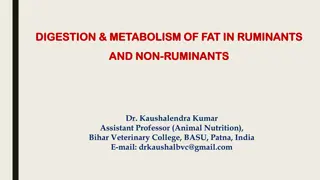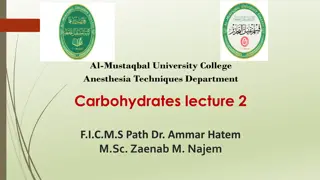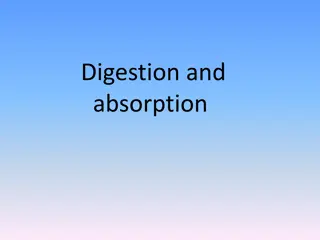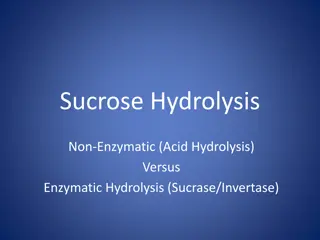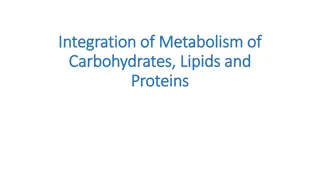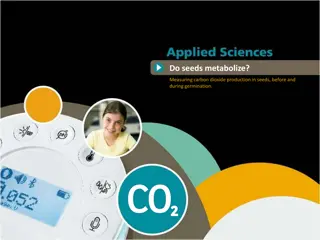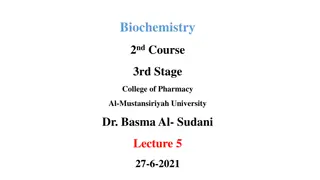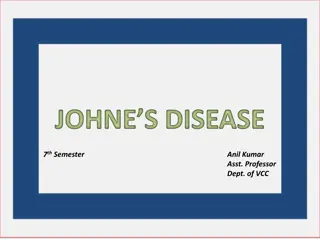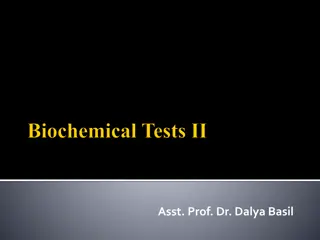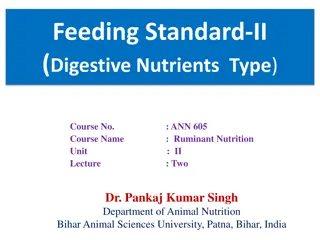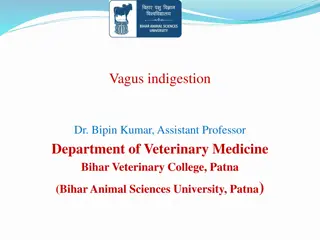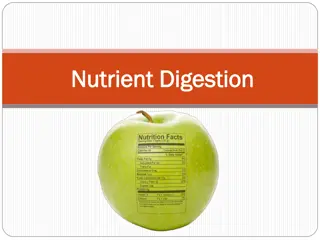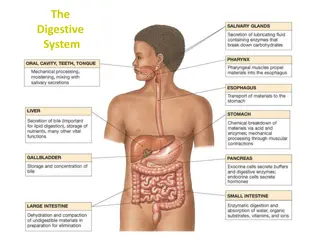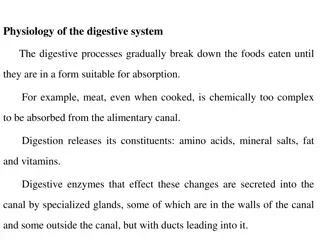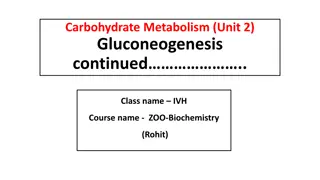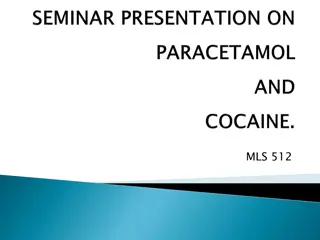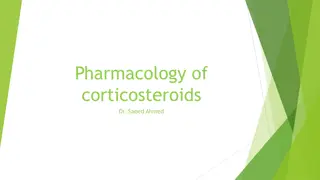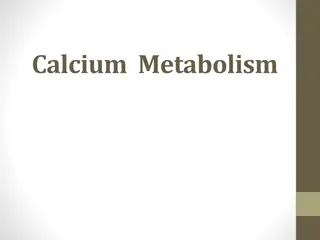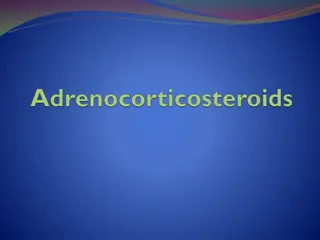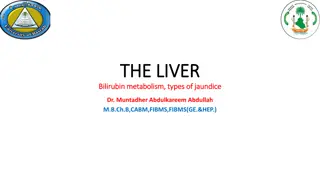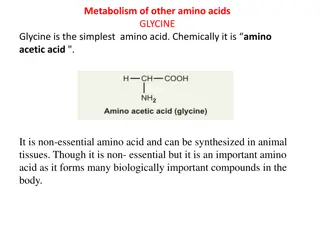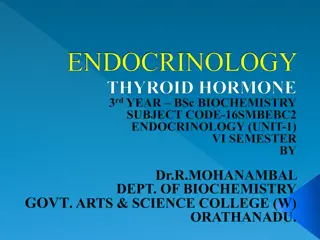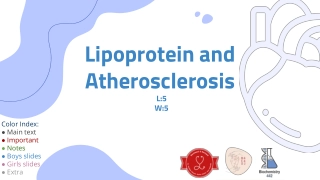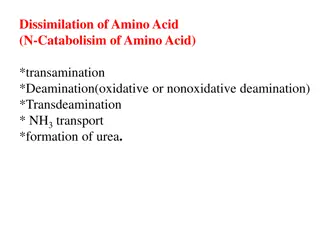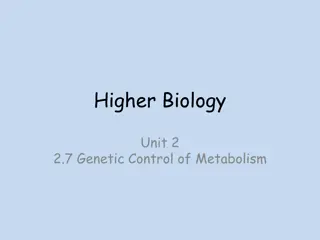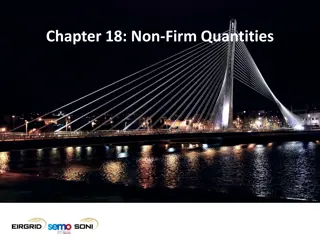Carbohydrate Digestion and Metabolism in Ruminants and Non-Ruminants
Digestion and absorption of carbohydrates play a crucial role in the overall metabolism of ruminants and non-ruminants. This process involves various enzymes like amylase, maltase, lactase, and sucrase that break down complex carbohydrates into simpler forms for absorption in the small intestine. Ruminants have a unique digestive system with fermentation in the rumen, while non-ruminants rely on enzymatic breakdown in the gastrointestinal tract. Understanding the differences in carbohydrate processing between these animal groups is essential for optimal nutrition.
Download Presentation

Please find below an Image/Link to download the presentation.
The content on the website is provided AS IS for your information and personal use only. It may not be sold, licensed, or shared on other websites without obtaining consent from the author. Download presentation by click this link. If you encounter any issues during the download, it is possible that the publisher has removed the file from their server.
E N D
Presentation Transcript
DIGESTION & METABOLISM OF CARBOHYDRATE DIGESTION & METABOLISM OF CARBOHYDRATE FOR FOR RUMINANTS & NON RUMINANTS & NON- -RUMINANTS RUMINANTS Dr. Kaushalendra Kumar Assistant Professor (Animal Nutrition), Bihar Veterinary College, BASU, Patna, India E-mail: drkaushalbvc@gmail.com
Digestion & absorption of carbohydrates in monogastric Digestion & absorption of carbohydrates in monogastric Salivary Salivary digestion digestion in in mouth mouth Digestion Digestion in in the the gastrointestinal gastrointestinal tract tract Main Main organ organ for for the the absorption absorption of of dietary dietary nutrients nutrients by by the the monogastric monogastric mammal mammal is is small small intestine intestine (jejunum) (jejunum). .
Cont.... Cont....
Some common digestive enzymes with their sources & substrate Some common digestive enzymes with their sources & substrate Name of enzymes Name of enzymes Enzymes hydrolysing glycosidic linkages Enzymes hydrolysing glycosidic linkages - -Amylase (Diastase) Amylase (Diastase) Systematic name Systematic name Source Source Substrate Substrate 1, 4 1, 4- - - -D D- -Glucan Glucan Saliva, pancreas Saliva, pancreas Starch, glycogen, Starch, glycogen, glucanohydrolase glucanohydrolase Glucoside dextrin dextrin Maltose Maltose - -Glucosidase (Maltase) Glucosidase (Maltase) - -D D- -Glucoside Small intestine Small intestine glucohydrolase glucohydrolase Dextrin 6 Dextrin 6- - - - Oligo Oligo- -1,6 1,6- -glucosidase glucosidase Small intestine Small intestine Dextrin Dextrin (Iso (Iso- -maltase) maltase) - -Galactosidase Galactosidase glucanohydrolase glucanohydrolase - -D D- -Galactoside Galactoside Small intestine Small intestine Lactose Lactose (Lactase) (Lactase) - -Fructofuranosidase Fructofuranosidase galactohydrolase galactohydrolase - -D D- -Fructofuranoside Fructofuranoside Small intestine Small intestine Sucrose Sucrose (Sucrase) (Sucrase) Credit: McDonald et al. (2011). Animal Nutrition. Credit: McDonald et al. (2011). Animal Nutrition. fructohydrolase fructohydrolase
Digestion and absorption of carbohydrates in ruminants Digestion and absorption of carbohydrates in ruminants
Cont.... Cont....
Cont.... Cont....
Metabolism of carbohydrates Metabolism of carbohydrates There are three fundamental ways of metabolism of the absorbed CHO There are three fundamental ways of metabolism of the absorbed CHO Being used as an instant source of energy. Being used as an instant source of energy. Serves as a precursor of liver and muscle glycogen. Serves as a precursor of liver and muscle glycogen. To assist as a precursor of tissue triglycerides. To assist as a precursor of tissue triglycerides.
Cont.... Cont.... Glycolytic pathway Glycolytic pathway
Cont.... Cont.... TCA cycle TCA cycle
Cont.... Cont.... Pentose phosphate pathway Pentose phosphate pathway
Cont.... Cont.... Glucose as a source of energy Glucose as a source of energy Galactose as a source of energy Galactose as a source of energy Fructose as a source of energy Fructose as a source of energy Glycogen as a source of energy Glycogen as a source of energy Propionic acid as a source of energy Propionic acid as a source of energy Butyric acid as a source of energy Butyric acid as a source of energy Acetic acid as a source of energy Acetic acid as a source of energy
Cont.... Cont.... ATP yield from the complete oxidation of one mole of glucose ATP yield from the complete oxidation of one mole of glucose Reactions Reactions Glycolysis Glycolysis Glyceraldehyde Glyceraldehyde- -3 3- -phosphate dehydrogenase phosphate dehydrogenase Phosphoglycerate kinase Phosphoglycerate kinase Pyruvate kinase Pyruvate kinase High High- -energy bonds production energy bonds production ATP yield ATP yield Resp. chain oxidation of 2 NADH Resp. chain oxidation of 2 NADH Oxidation at substrate level Oxidation at substrate level Oxidation at substrate level Oxidation at substrate level 6 6a a 2 2 2 2 10 10 - -2 2 8 8 ATP consumption by hexokinase and phosphofructokinase ATP consumption by hexokinase and phosphofructokinase Net Net Citric acid cycle Citric acid cycle Pyruvate dehydrogenase Pyruvate dehydrogenase Isocitrate dehydrogenase Isocitrate dehydrogenase - -ketoglutarate dehydrogenase ketoglutarate dehydrogenase Succinate thiokinase Succinate thiokinase Succinate dehydrogenase Succinate dehydrogenase Malate dehydrogenase Malate dehydrogenase Resp. chain oxidation of 2 NADH Resp. chain oxidation of 2 NADH Resp. chain oxidation of 2 NADH Resp. chain oxidation of 2 NADH Resp. chain oxidation of 2 NADH Resp. chain oxidation of 2 NADH Oxidation at substrate level Oxidation at substrate level Resp. chain oxidation of 2 FADH Resp. chain oxidation of 2 FADH2 2 Resp. chain oxidation of 2 NADH Resp. chain oxidation of 2 NADH 6 6 6 6 6 6 2 2 4 4 6 6 30 30 38 38 2 2 Net Net Total per mol of glucose under aerobic conditions Total per mol of glucose under aerobic conditions Total per mol of glucose under anaerobic conditions Total per mol of glucose under anaerobic conditions Assuming that NADH formed in glycolysis is transported to mitochondria via malate pathway. If the glycerophosphate a aAssuming that NADH formed in glycolysis is transported to mitochondria via malate pathway. If the glycerophosphate pathway is used, only 2 ATP would be formed per mol of NADH, and a total net production are to be 36 instead of 38. pathway is used, only 2 ATP would be formed per mol of NADH, and a total net production are to be 36 instead of 38. Credit: Martin et al. (1983). Credit: Martin et al. (1983).
Cont.... Cont.... Glycogen metabolism Glycogen metabolism
Cont.... Cont.... Propionate and acetate conversion to glucose Propionate and acetate conversion to glucose
Cont.... Cont.... Formation of Acetyl Formation of Acetyl- -CoA from butyrate CoA from butyrate
Discussion.......... Questions, if any? THANKS



